HSC230 - Assessment 2: Personal Cultural Safety Action Plan Report
VerifiedAdded on 2022/11/15
|6
|2267
|441
Report
AI Summary
This report presents a comprehensive cultural safety action plan developed by a student for their HSC230 assessment. The plan focuses on implementing culturally safe practices within a healthcare setting, emphasizing person-centered care and adherence to the NMBA code of conduct and NSQHS standards. The action plan includes specific goals, such as effective communication with patients of diverse cultures, and outlines objectives, strategies, and resources to achieve these goals, including training and the establishment of a culturally safe therapeutic environment. The report also addresses anticipated barriers, such as lack of understanding among care professionals, and proposes strategies to overcome them, such as mandatory training and performance incentives. Part two provides a rationale for the plan, discussing the importance of cultural safety in nursing, the need for a personal action plan, implementation strategies, and evaluation methods. The student emphasizes the use of the Purnell Model for Cultural Competence to understand cultural differences and promote positive patient outcomes. The report concludes with a reflection on the plan's quality and its potential to improve patient care and ensure cultural safety.
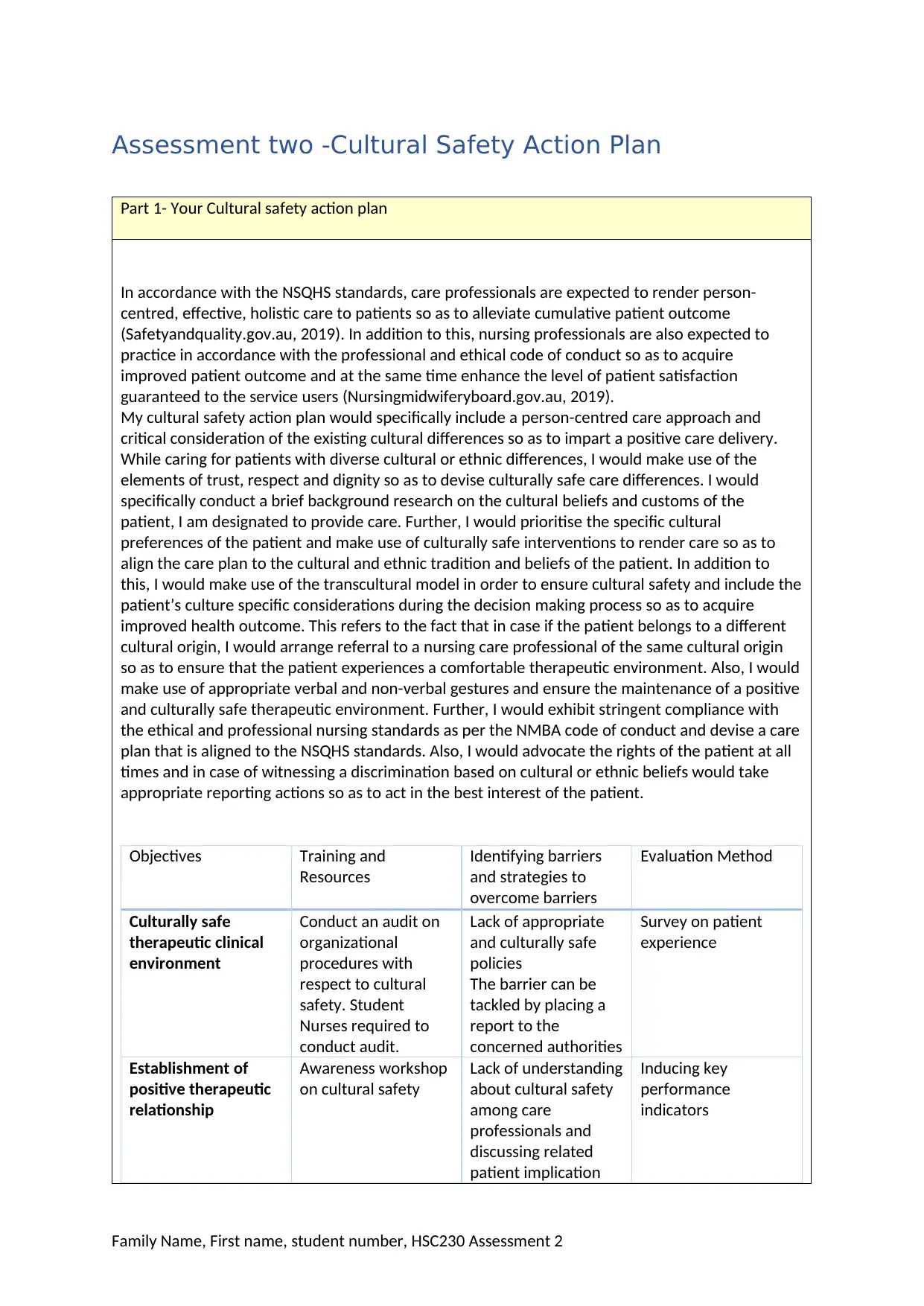
Assessment two -Cultural Safety Action Plan
Part 1- Your Cultural safety action plan
In accordance with the NSQHS standards, care professionals are expected to render person-
centred, effective, holistic care to patients so as to alleviate cumulative patient outcome
(Safetyandquality.gov.au, 2019). In addition to this, nursing professionals are also expected to
practice in accordance with the professional and ethical code of conduct so as to acquire
improved patient outcome and at the same time enhance the level of patient satisfaction
guaranteed to the service users (Nursingmidwiferyboard.gov.au, 2019).
My cultural safety action plan would specifically include a person-centred care approach and
critical consideration of the existing cultural differences so as to impart a positive care delivery.
While caring for patients with diverse cultural or ethnic differences, I would make use of the
elements of trust, respect and dignity so as to devise culturally safe care differences. I would
specifically conduct a brief background research on the cultural beliefs and customs of the
patient, I am designated to provide care. Further, I would prioritise the specific cultural
preferences of the patient and make use of culturally safe interventions to render care so as to
align the care plan to the cultural and ethnic tradition and beliefs of the patient. In addition to
this, I would make use of the transcultural model in order to ensure cultural safety and include the
patient’s culture specific considerations during the decision making process so as to acquire
improved health outcome. This refers to the fact that in case if the patient belongs to a different
cultural origin, I would arrange referral to a nursing care professional of the same cultural origin
so as to ensure that the patient experiences a comfortable therapeutic environment. Also, I would
make use of appropriate verbal and non-verbal gestures and ensure the maintenance of a positive
and culturally safe therapeutic environment. Further, I would exhibit stringent compliance with
the ethical and professional nursing standards as per the NMBA code of conduct and devise a care
plan that is aligned to the NSQHS standards. Also, I would advocate the rights of the patient at all
times and in case of witnessing a discrimination based on cultural or ethnic beliefs would take
appropriate reporting actions so as to act in the best interest of the patient.
Objectives Training and
Resources
Identifying barriers
and strategies to
overcome barriers
Evaluation Method
Culturally safe
therapeutic clinical
environment
Conduct an audit on
organizational
procedures with
respect to cultural
safety. Student
Nurses required to
conduct audit.
Lack of appropriate
and culturally safe
policies
The barrier can be
tackled by placing a
report to the
concerned authorities
Survey on patient
experience
Establishment of
positive therapeutic
relationship
Awareness workshop
on cultural safety
Lack of understanding
about cultural safety
among care
professionals and
discussing related
patient implication
Inducing key
performance
indicators
Family Name, First name, student number, HSC230 Assessment 2
Part 1- Your Cultural safety action plan
In accordance with the NSQHS standards, care professionals are expected to render person-
centred, effective, holistic care to patients so as to alleviate cumulative patient outcome
(Safetyandquality.gov.au, 2019). In addition to this, nursing professionals are also expected to
practice in accordance with the professional and ethical code of conduct so as to acquire
improved patient outcome and at the same time enhance the level of patient satisfaction
guaranteed to the service users (Nursingmidwiferyboard.gov.au, 2019).
My cultural safety action plan would specifically include a person-centred care approach and
critical consideration of the existing cultural differences so as to impart a positive care delivery.
While caring for patients with diverse cultural or ethnic differences, I would make use of the
elements of trust, respect and dignity so as to devise culturally safe care differences. I would
specifically conduct a brief background research on the cultural beliefs and customs of the
patient, I am designated to provide care. Further, I would prioritise the specific cultural
preferences of the patient and make use of culturally safe interventions to render care so as to
align the care plan to the cultural and ethnic tradition and beliefs of the patient. In addition to
this, I would make use of the transcultural model in order to ensure cultural safety and include the
patient’s culture specific considerations during the decision making process so as to acquire
improved health outcome. This refers to the fact that in case if the patient belongs to a different
cultural origin, I would arrange referral to a nursing care professional of the same cultural origin
so as to ensure that the patient experiences a comfortable therapeutic environment. Also, I would
make use of appropriate verbal and non-verbal gestures and ensure the maintenance of a positive
and culturally safe therapeutic environment. Further, I would exhibit stringent compliance with
the ethical and professional nursing standards as per the NMBA code of conduct and devise a care
plan that is aligned to the NSQHS standards. Also, I would advocate the rights of the patient at all
times and in case of witnessing a discrimination based on cultural or ethnic beliefs would take
appropriate reporting actions so as to act in the best interest of the patient.
Objectives Training and
Resources
Identifying barriers
and strategies to
overcome barriers
Evaluation Method
Culturally safe
therapeutic clinical
environment
Conduct an audit on
organizational
procedures with
respect to cultural
safety. Student
Nurses required to
conduct audit.
Lack of appropriate
and culturally safe
policies
The barrier can be
tackled by placing a
report to the
concerned authorities
Survey on patient
experience
Establishment of
positive therapeutic
relationship
Awareness workshop
on cultural safety
Lack of understanding
about cultural safety
among care
professionals and
discussing related
patient implication
Inducing key
performance
indicators
Family Name, First name, student number, HSC230 Assessment 2
Paraphrase This Document
Need a fresh take? Get an instant paraphrase of this document with our AI Paraphraser
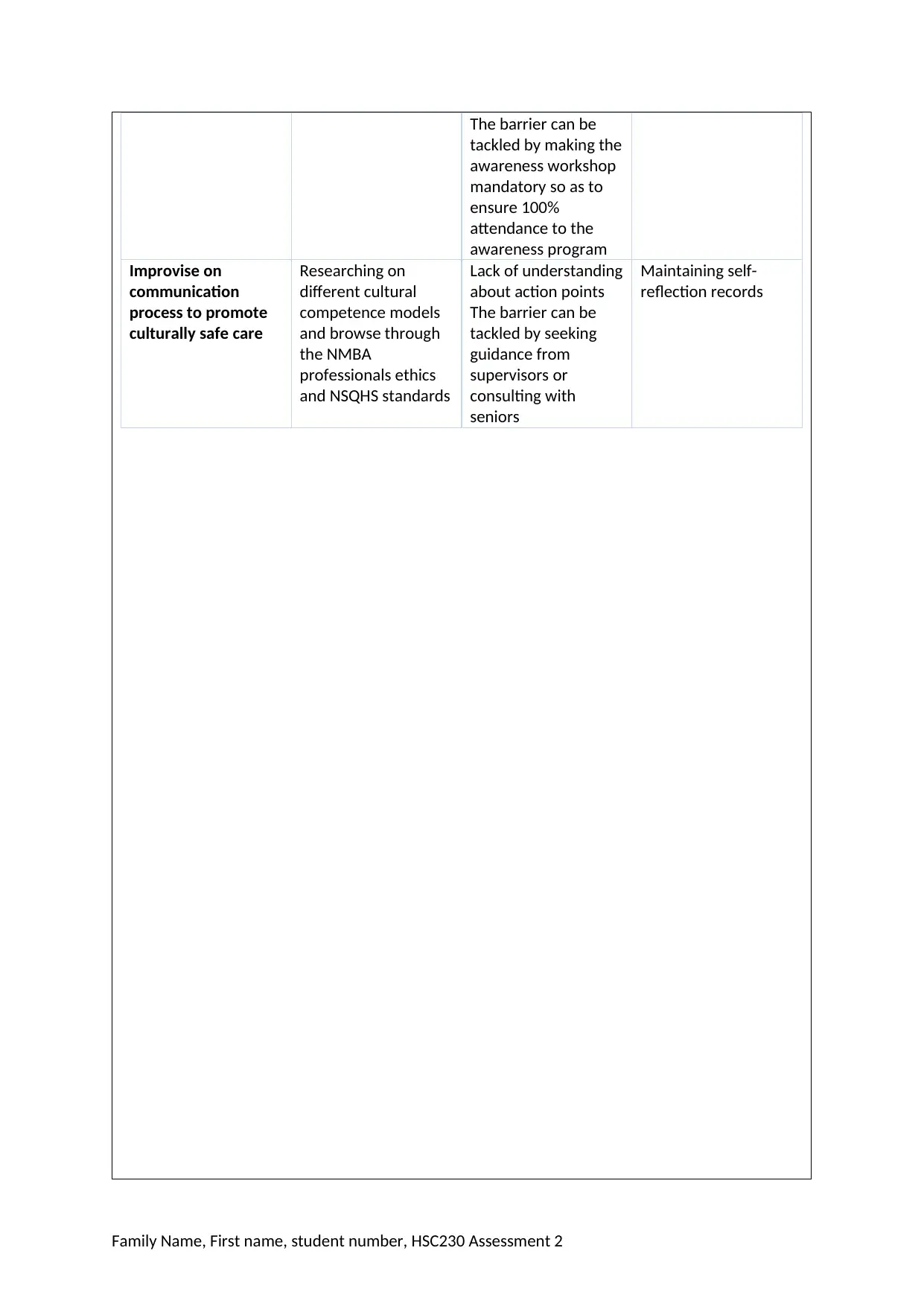
The barrier can be
tackled by making the
awareness workshop
mandatory so as to
ensure 100%
attendance to the
awareness program
Improvise on
communication
process to promote
culturally safe care
Researching on
different cultural
competence models
and browse through
the NMBA
professionals ethics
and NSQHS standards
Lack of understanding
about action points
The barrier can be
tackled by seeking
guidance from
supervisors or
consulting with
seniors
Maintaining self-
reflection records
Family Name, First name, student number, HSC230 Assessment 2
tackled by making the
awareness workshop
mandatory so as to
ensure 100%
attendance to the
awareness program
Improvise on
communication
process to promote
culturally safe care
Researching on
different cultural
competence models
and browse through
the NMBA
professionals ethics
and NSQHS standards
Lack of understanding
about action points
The barrier can be
tackled by seeking
guidance from
supervisors or
consulting with
seniors
Maintaining self-
reflection records
Family Name, First name, student number, HSC230 Assessment 2
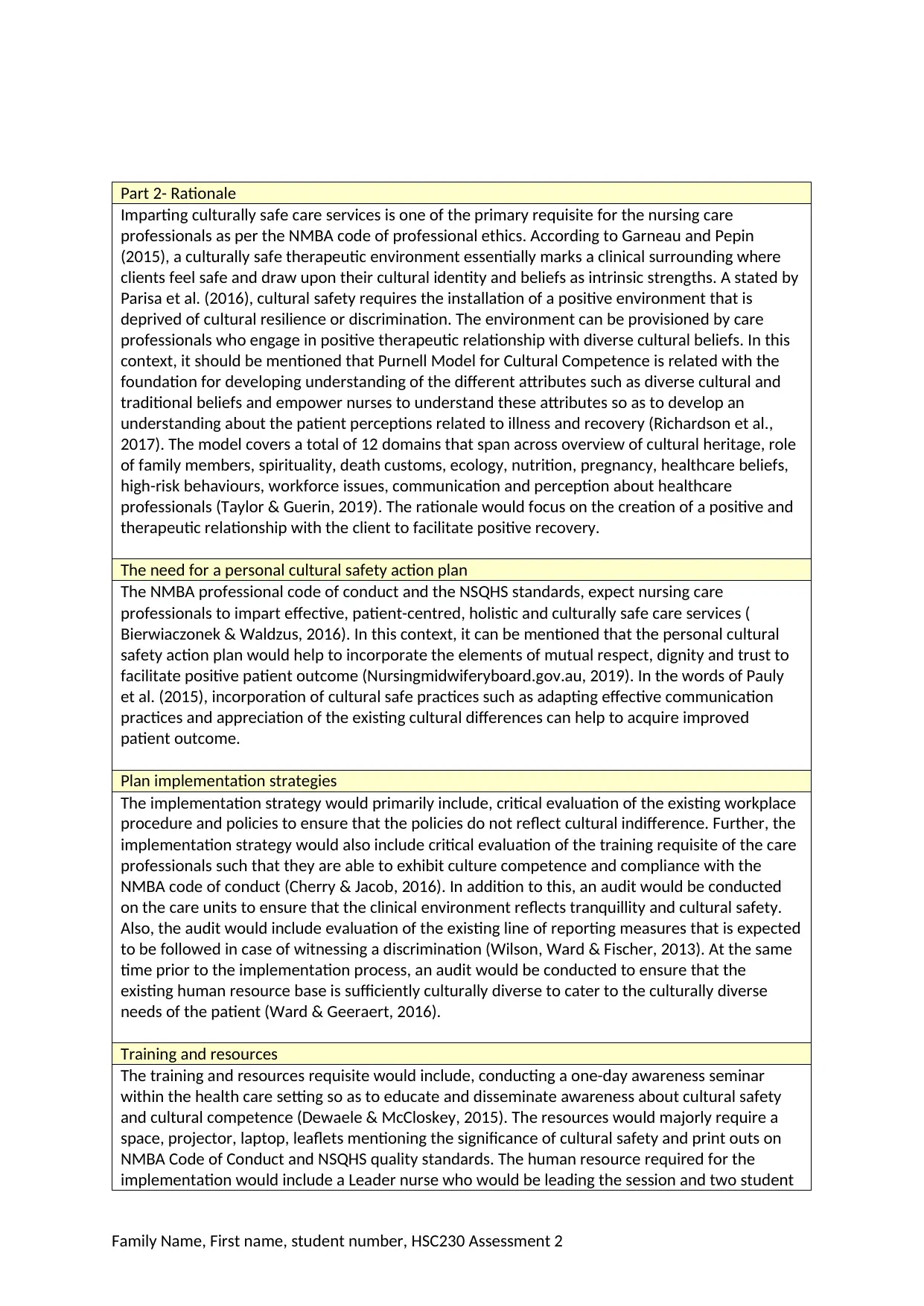
Part 2- Rationale
Imparting culturally safe care services is one of the primary requisite for the nursing care
professionals as per the NMBA code of professional ethics. According to Garneau and Pepin
(2015), a culturally safe therapeutic environment essentially marks a clinical surrounding where
clients feel safe and draw upon their cultural identity and beliefs as intrinsic strengths. A stated by
Parisa et al. (2016), cultural safety requires the installation of a positive environment that is
deprived of cultural resilience or discrimination. The environment can be provisioned by care
professionals who engage in positive therapeutic relationship with diverse cultural beliefs. In this
context, it should be mentioned that Purnell Model for Cultural Competence is related with the
foundation for developing understanding of the different attributes such as diverse cultural and
traditional beliefs and empower nurses to understand these attributes so as to develop an
understanding about the patient perceptions related to illness and recovery (Richardson et al.,
2017). The model covers a total of 12 domains that span across overview of cultural heritage, role
of family members, spirituality, death customs, ecology, nutrition, pregnancy, healthcare beliefs,
high-risk behaviours, workforce issues, communication and perception about healthcare
professionals (Taylor & Guerin, 2019). The rationale would focus on the creation of a positive and
therapeutic relationship with the client to facilitate positive recovery.
The need for a personal cultural safety action plan
The NMBA professional code of conduct and the NSQHS standards, expect nursing care
professionals to impart effective, patient-centred, holistic and culturally safe care services (
Bierwiaczonek & Waldzus, 2016). In this context, it can be mentioned that the personal cultural
safety action plan would help to incorporate the elements of mutual respect, dignity and trust to
facilitate positive patient outcome (Nursingmidwiferyboard.gov.au, 2019). In the words of Pauly
et al. (2015), incorporation of cultural safe practices such as adapting effective communication
practices and appreciation of the existing cultural differences can help to acquire improved
patient outcome.
Plan implementation strategies
The implementation strategy would primarily include, critical evaluation of the existing workplace
procedure and policies to ensure that the policies do not reflect cultural indifference. Further, the
implementation strategy would also include critical evaluation of the training requisite of the care
professionals such that they are able to exhibit culture competence and compliance with the
NMBA code of conduct (Cherry & Jacob, 2016). In addition to this, an audit would be conducted
on the care units to ensure that the clinical environment reflects tranquillity and cultural safety.
Also, the audit would include evaluation of the existing line of reporting measures that is expected
to be followed in case of witnessing a discrimination (Wilson, Ward & Fischer, 2013). At the same
time prior to the implementation process, an audit would be conducted to ensure that the
existing human resource base is sufficiently culturally diverse to cater to the culturally diverse
needs of the patient (Ward & Geeraert, 2016).
Training and resources
The training and resources requisite would include, conducting a one-day awareness seminar
within the health care setting so as to educate and disseminate awareness about cultural safety
and cultural competence (Dewaele & McCloskey, 2015). The resources would majorly require a
space, projector, laptop, leaflets mentioning the significance of cultural safety and print outs on
NMBA Code of Conduct and NSQHS quality standards. The human resource required for the
implementation would include a Leader nurse who would be leading the session and two student
Family Name, First name, student number, HSC230 Assessment 2
Imparting culturally safe care services is one of the primary requisite for the nursing care
professionals as per the NMBA code of professional ethics. According to Garneau and Pepin
(2015), a culturally safe therapeutic environment essentially marks a clinical surrounding where
clients feel safe and draw upon their cultural identity and beliefs as intrinsic strengths. A stated by
Parisa et al. (2016), cultural safety requires the installation of a positive environment that is
deprived of cultural resilience or discrimination. The environment can be provisioned by care
professionals who engage in positive therapeutic relationship with diverse cultural beliefs. In this
context, it should be mentioned that Purnell Model for Cultural Competence is related with the
foundation for developing understanding of the different attributes such as diverse cultural and
traditional beliefs and empower nurses to understand these attributes so as to develop an
understanding about the patient perceptions related to illness and recovery (Richardson et al.,
2017). The model covers a total of 12 domains that span across overview of cultural heritage, role
of family members, spirituality, death customs, ecology, nutrition, pregnancy, healthcare beliefs,
high-risk behaviours, workforce issues, communication and perception about healthcare
professionals (Taylor & Guerin, 2019). The rationale would focus on the creation of a positive and
therapeutic relationship with the client to facilitate positive recovery.
The need for a personal cultural safety action plan
The NMBA professional code of conduct and the NSQHS standards, expect nursing care
professionals to impart effective, patient-centred, holistic and culturally safe care services (
Bierwiaczonek & Waldzus, 2016). In this context, it can be mentioned that the personal cultural
safety action plan would help to incorporate the elements of mutual respect, dignity and trust to
facilitate positive patient outcome (Nursingmidwiferyboard.gov.au, 2019). In the words of Pauly
et al. (2015), incorporation of cultural safe practices such as adapting effective communication
practices and appreciation of the existing cultural differences can help to acquire improved
patient outcome.
Plan implementation strategies
The implementation strategy would primarily include, critical evaluation of the existing workplace
procedure and policies to ensure that the policies do not reflect cultural indifference. Further, the
implementation strategy would also include critical evaluation of the training requisite of the care
professionals such that they are able to exhibit culture competence and compliance with the
NMBA code of conduct (Cherry & Jacob, 2016). In addition to this, an audit would be conducted
on the care units to ensure that the clinical environment reflects tranquillity and cultural safety.
Also, the audit would include evaluation of the existing line of reporting measures that is expected
to be followed in case of witnessing a discrimination (Wilson, Ward & Fischer, 2013). At the same
time prior to the implementation process, an audit would be conducted to ensure that the
existing human resource base is sufficiently culturally diverse to cater to the culturally diverse
needs of the patient (Ward & Geeraert, 2016).
Training and resources
The training and resources requisite would include, conducting a one-day awareness seminar
within the health care setting so as to educate and disseminate awareness about cultural safety
and cultural competence (Dewaele & McCloskey, 2015). The resources would majorly require a
space, projector, laptop, leaflets mentioning the significance of cultural safety and print outs on
NMBA Code of Conduct and NSQHS quality standards. The human resource required for the
implementation would include a Leader nurse who would be leading the session and two student
Family Name, First name, student number, HSC230 Assessment 2
⊘ This is a preview!⊘
Do you want full access?
Subscribe today to unlock all pages.

Trusted by 1+ million students worldwide
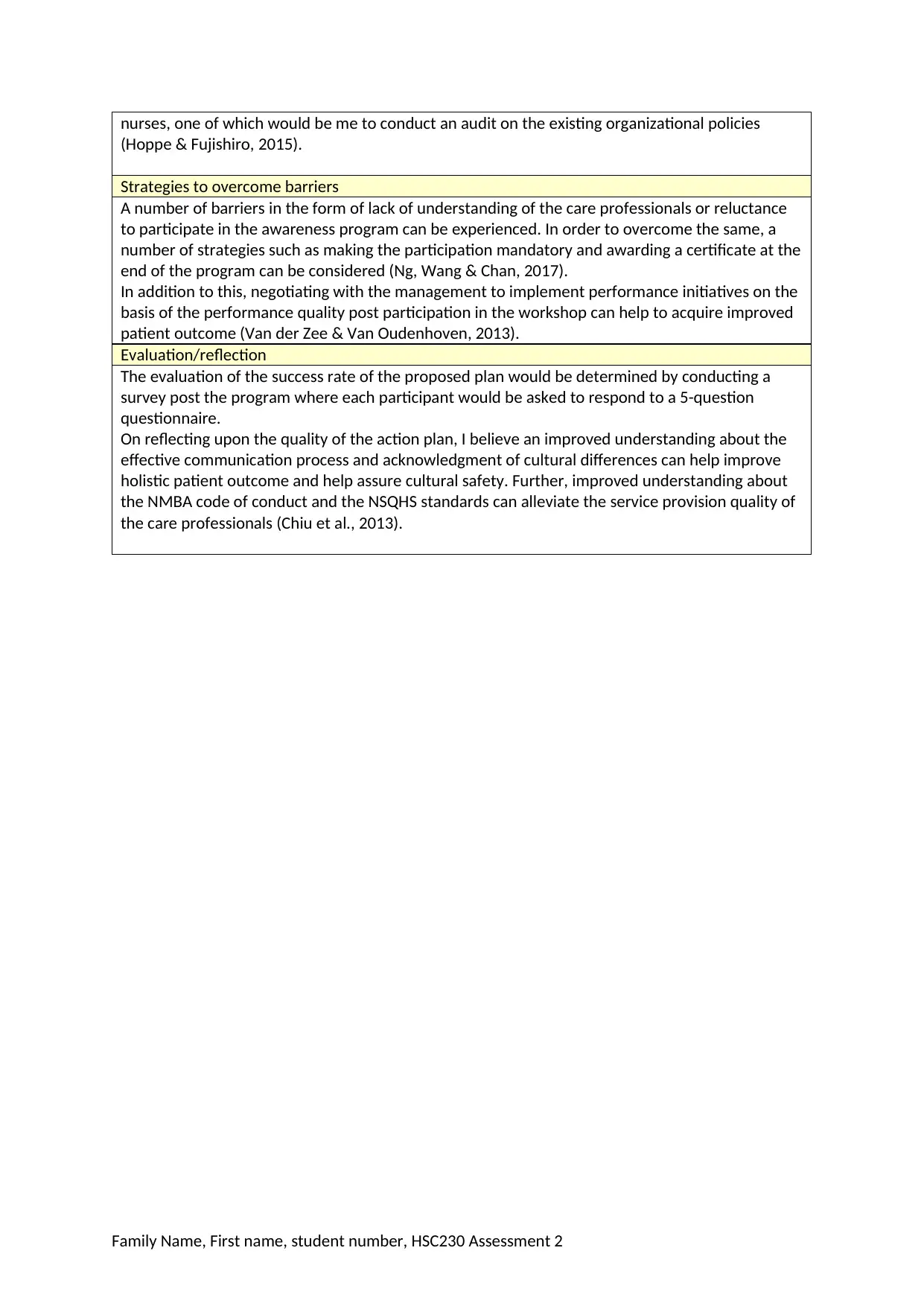
nurses, one of which would be me to conduct an audit on the existing organizational policies
(Hoppe & Fujishiro, 2015).
Strategies to overcome barriers
A number of barriers in the form of lack of understanding of the care professionals or reluctance
to participate in the awareness program can be experienced. In order to overcome the same, a
number of strategies such as making the participation mandatory and awarding a certificate at the
end of the program can be considered (Ng, Wang & Chan, 2017).
In addition to this, negotiating with the management to implement performance initiatives on the
basis of the performance quality post participation in the workshop can help to acquire improved
patient outcome (Van der Zee & Van Oudenhoven, 2013).
Evaluation/reflection
The evaluation of the success rate of the proposed plan would be determined by conducting a
survey post the program where each participant would be asked to respond to a 5-question
questionnaire.
On reflecting upon the quality of the action plan, I believe an improved understanding about the
effective communication process and acknowledgment of cultural differences can help improve
holistic patient outcome and help assure cultural safety. Further, improved understanding about
the NMBA code of conduct and the NSQHS standards can alleviate the service provision quality of
the care professionals (Chiu et al., 2013).
Family Name, First name, student number, HSC230 Assessment 2
(Hoppe & Fujishiro, 2015).
Strategies to overcome barriers
A number of barriers in the form of lack of understanding of the care professionals or reluctance
to participate in the awareness program can be experienced. In order to overcome the same, a
number of strategies such as making the participation mandatory and awarding a certificate at the
end of the program can be considered (Ng, Wang & Chan, 2017).
In addition to this, negotiating with the management to implement performance initiatives on the
basis of the performance quality post participation in the workshop can help to acquire improved
patient outcome (Van der Zee & Van Oudenhoven, 2013).
Evaluation/reflection
The evaluation of the success rate of the proposed plan would be determined by conducting a
survey post the program where each participant would be asked to respond to a 5-question
questionnaire.
On reflecting upon the quality of the action plan, I believe an improved understanding about the
effective communication process and acknowledgment of cultural differences can help improve
holistic patient outcome and help assure cultural safety. Further, improved understanding about
the NMBA code of conduct and the NSQHS standards can alleviate the service provision quality of
the care professionals (Chiu et al., 2013).
Family Name, First name, student number, HSC230 Assessment 2
Paraphrase This Document
Need a fresh take? Get an instant paraphrase of this document with our AI Paraphraser
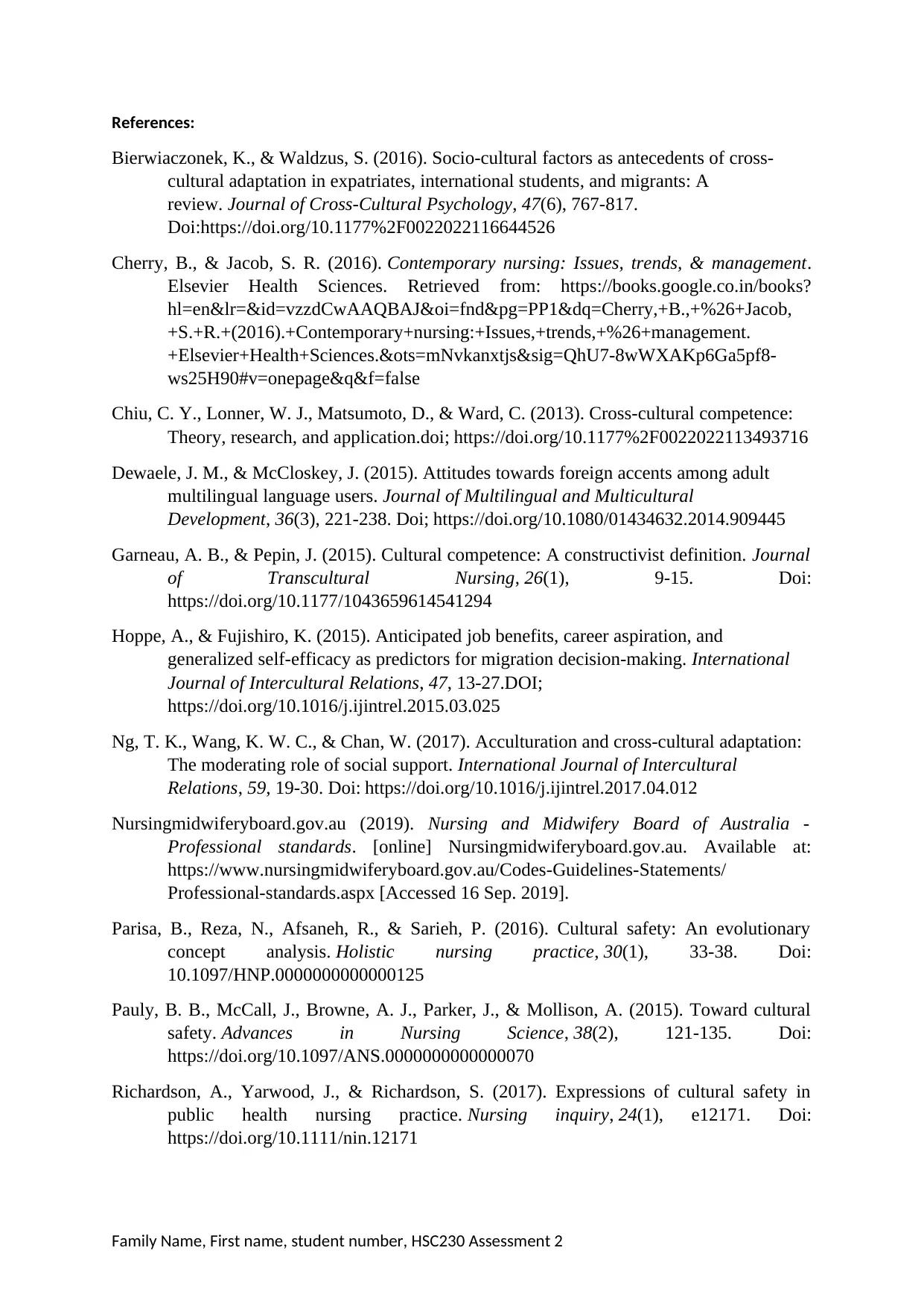
References:
Bierwiaczonek, K., & Waldzus, S. (2016). Socio-cultural factors as antecedents of cross-
cultural adaptation in expatriates, international students, and migrants: A
review. Journal of Cross-Cultural Psychology, 47(6), 767-817.
Doi:https://doi.org/10.1177%2F0022022116644526
Cherry, B., & Jacob, S. R. (2016). Contemporary nursing: Issues, trends, & management.
Elsevier Health Sciences. Retrieved from: https://books.google.co.in/books?
hl=en&lr=&id=vzzdCwAAQBAJ&oi=fnd&pg=PP1&dq=Cherry,+B.,+%26+Jacob,
+S.+R.+(2016).+Contemporary+nursing:+Issues,+trends,+%26+management.
+Elsevier+Health+Sciences.&ots=mNvkanxtjs&sig=QhU7-8wWXAKp6Ga5pf8-
ws25H90#v=onepage&q&f=false
Chiu, C. Y., Lonner, W. J., Matsumoto, D., & Ward, C. (2013). Cross-cultural competence:
Theory, research, and application.doi; https://doi.org/10.1177%2F0022022113493716
Dewaele, J. M., & McCloskey, J. (2015). Attitudes towards foreign accents among adult
multilingual language users. Journal of Multilingual and Multicultural
Development, 36(3), 221-238. Doi; https://doi.org/10.1080/01434632.2014.909445
Garneau, A. B., & Pepin, J. (2015). Cultural competence: A constructivist definition. Journal
of Transcultural Nursing, 26(1), 9-15. Doi:
https://doi.org/10.1177/1043659614541294
Hoppe, A., & Fujishiro, K. (2015). Anticipated job benefits, career aspiration, and
generalized self-efficacy as predictors for migration decision-making. International
Journal of Intercultural Relations, 47, 13-27.DOI;
https://doi.org/10.1016/j.ijintrel.2015.03.025
Ng, T. K., Wang, K. W. C., & Chan, W. (2017). Acculturation and cross-cultural adaptation:
The moderating role of social support. International Journal of Intercultural
Relations, 59, 19-30. Doi: https://doi.org/10.1016/j.ijintrel.2017.04.012
Nursingmidwiferyboard.gov.au (2019). Nursing and Midwifery Board of Australia -
Professional standards. [online] Nursingmidwiferyboard.gov.au. Available at:
https://www.nursingmidwiferyboard.gov.au/Codes-Guidelines-Statements/
Professional-standards.aspx [Accessed 16 Sep. 2019].
Parisa, B., Reza, N., Afsaneh, R., & Sarieh, P. (2016). Cultural safety: An evolutionary
concept analysis. Holistic nursing practice, 30(1), 33-38. Doi:
10.1097/HNP.0000000000000125
Pauly, B. B., McCall, J., Browne, A. J., Parker, J., & Mollison, A. (2015). Toward cultural
safety. Advances in Nursing Science, 38(2), 121-135. Doi:
https://doi.org/10.1097/ANS.0000000000000070
Richardson, A., Yarwood, J., & Richardson, S. (2017). Expressions of cultural safety in
public health nursing practice. Nursing inquiry, 24(1), e12171. Doi:
https://doi.org/10.1111/nin.12171
Family Name, First name, student number, HSC230 Assessment 2
Bierwiaczonek, K., & Waldzus, S. (2016). Socio-cultural factors as antecedents of cross-
cultural adaptation in expatriates, international students, and migrants: A
review. Journal of Cross-Cultural Psychology, 47(6), 767-817.
Doi:https://doi.org/10.1177%2F0022022116644526
Cherry, B., & Jacob, S. R. (2016). Contemporary nursing: Issues, trends, & management.
Elsevier Health Sciences. Retrieved from: https://books.google.co.in/books?
hl=en&lr=&id=vzzdCwAAQBAJ&oi=fnd&pg=PP1&dq=Cherry,+B.,+%26+Jacob,
+S.+R.+(2016).+Contemporary+nursing:+Issues,+trends,+%26+management.
+Elsevier+Health+Sciences.&ots=mNvkanxtjs&sig=QhU7-8wWXAKp6Ga5pf8-
ws25H90#v=onepage&q&f=false
Chiu, C. Y., Lonner, W. J., Matsumoto, D., & Ward, C. (2013). Cross-cultural competence:
Theory, research, and application.doi; https://doi.org/10.1177%2F0022022113493716
Dewaele, J. M., & McCloskey, J. (2015). Attitudes towards foreign accents among adult
multilingual language users. Journal of Multilingual and Multicultural
Development, 36(3), 221-238. Doi; https://doi.org/10.1080/01434632.2014.909445
Garneau, A. B., & Pepin, J. (2015). Cultural competence: A constructivist definition. Journal
of Transcultural Nursing, 26(1), 9-15. Doi:
https://doi.org/10.1177/1043659614541294
Hoppe, A., & Fujishiro, K. (2015). Anticipated job benefits, career aspiration, and
generalized self-efficacy as predictors for migration decision-making. International
Journal of Intercultural Relations, 47, 13-27.DOI;
https://doi.org/10.1016/j.ijintrel.2015.03.025
Ng, T. K., Wang, K. W. C., & Chan, W. (2017). Acculturation and cross-cultural adaptation:
The moderating role of social support. International Journal of Intercultural
Relations, 59, 19-30. Doi: https://doi.org/10.1016/j.ijintrel.2017.04.012
Nursingmidwiferyboard.gov.au (2019). Nursing and Midwifery Board of Australia -
Professional standards. [online] Nursingmidwiferyboard.gov.au. Available at:
https://www.nursingmidwiferyboard.gov.au/Codes-Guidelines-Statements/
Professional-standards.aspx [Accessed 16 Sep. 2019].
Parisa, B., Reza, N., Afsaneh, R., & Sarieh, P. (2016). Cultural safety: An evolutionary
concept analysis. Holistic nursing practice, 30(1), 33-38. Doi:
10.1097/HNP.0000000000000125
Pauly, B. B., McCall, J., Browne, A. J., Parker, J., & Mollison, A. (2015). Toward cultural
safety. Advances in Nursing Science, 38(2), 121-135. Doi:
https://doi.org/10.1097/ANS.0000000000000070
Richardson, A., Yarwood, J., & Richardson, S. (2017). Expressions of cultural safety in
public health nursing practice. Nursing inquiry, 24(1), e12171. Doi:
https://doi.org/10.1111/nin.12171
Family Name, First name, student number, HSC230 Assessment 2
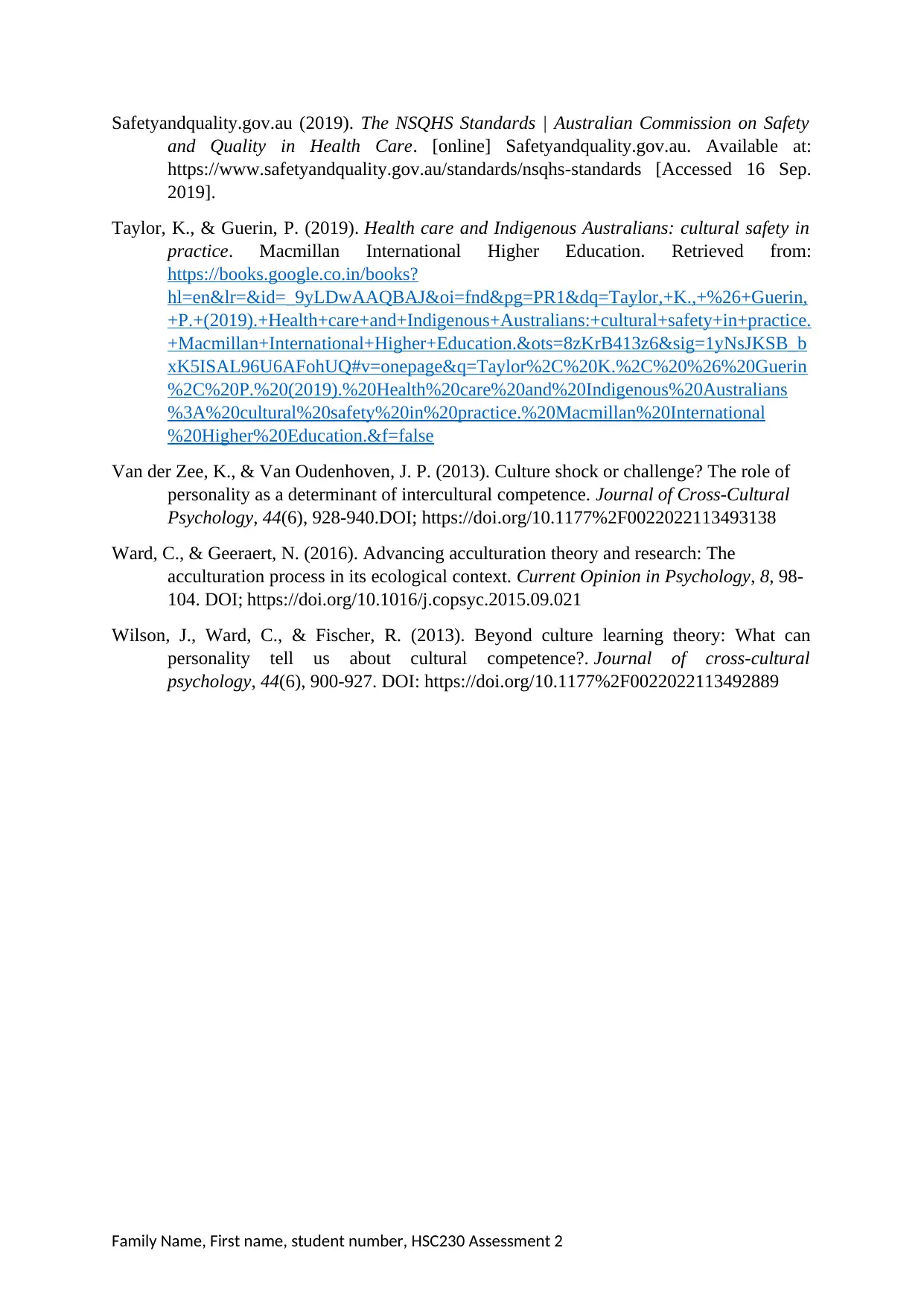
Safetyandquality.gov.au (2019). The NSQHS Standards | Australian Commission on Safety
and Quality in Health Care. [online] Safetyandquality.gov.au. Available at:
https://www.safetyandquality.gov.au/standards/nsqhs-standards [Accessed 16 Sep.
2019].
Taylor, K., & Guerin, P. (2019). Health care and Indigenous Australians: cultural safety in
practice. Macmillan International Higher Education. Retrieved from:
https://books.google.co.in/books?
hl=en&lr=&id=_9yLDwAAQBAJ&oi=fnd&pg=PR1&dq=Taylor,+K.,+%26+Guerin,
+P.+(2019).+Health+care+and+Indigenous+Australians:+cultural+safety+in+practice.
+Macmillan+International+Higher+Education.&ots=8zKrB413z6&sig=1yNsJKSB_b
xK5ISAL96U6AFohUQ#v=onepage&q=Taylor%2C%20K.%2C%20%26%20Guerin
%2C%20P.%20(2019).%20Health%20care%20and%20Indigenous%20Australians
%3A%20cultural%20safety%20in%20practice.%20Macmillan%20International
%20Higher%20Education.&f=false
Van der Zee, K., & Van Oudenhoven, J. P. (2013). Culture shock or challenge? The role of
personality as a determinant of intercultural competence. Journal of Cross-Cultural
Psychology, 44(6), 928-940.DOI; https://doi.org/10.1177%2F0022022113493138
Ward, C., & Geeraert, N. (2016). Advancing acculturation theory and research: The
acculturation process in its ecological context. Current Opinion in Psychology, 8, 98-
104. DOI; https://doi.org/10.1016/j.copsyc.2015.09.021
Wilson, J., Ward, C., & Fischer, R. (2013). Beyond culture learning theory: What can
personality tell us about cultural competence?. Journal of cross-cultural
psychology, 44(6), 900-927. DOI: https://doi.org/10.1177%2F0022022113492889
Family Name, First name, student number, HSC230 Assessment 2
and Quality in Health Care. [online] Safetyandquality.gov.au. Available at:
https://www.safetyandquality.gov.au/standards/nsqhs-standards [Accessed 16 Sep.
2019].
Taylor, K., & Guerin, P. (2019). Health care and Indigenous Australians: cultural safety in
practice. Macmillan International Higher Education. Retrieved from:
https://books.google.co.in/books?
hl=en&lr=&id=_9yLDwAAQBAJ&oi=fnd&pg=PR1&dq=Taylor,+K.,+%26+Guerin,
+P.+(2019).+Health+care+and+Indigenous+Australians:+cultural+safety+in+practice.
+Macmillan+International+Higher+Education.&ots=8zKrB413z6&sig=1yNsJKSB_b
xK5ISAL96U6AFohUQ#v=onepage&q=Taylor%2C%20K.%2C%20%26%20Guerin
%2C%20P.%20(2019).%20Health%20care%20and%20Indigenous%20Australians
%3A%20cultural%20safety%20in%20practice.%20Macmillan%20International
%20Higher%20Education.&f=false
Van der Zee, K., & Van Oudenhoven, J. P. (2013). Culture shock or challenge? The role of
personality as a determinant of intercultural competence. Journal of Cross-Cultural
Psychology, 44(6), 928-940.DOI; https://doi.org/10.1177%2F0022022113493138
Ward, C., & Geeraert, N. (2016). Advancing acculturation theory and research: The
acculturation process in its ecological context. Current Opinion in Psychology, 8, 98-
104. DOI; https://doi.org/10.1016/j.copsyc.2015.09.021
Wilson, J., Ward, C., & Fischer, R. (2013). Beyond culture learning theory: What can
personality tell us about cultural competence?. Journal of cross-cultural
psychology, 44(6), 900-927. DOI: https://doi.org/10.1177%2F0022022113492889
Family Name, First name, student number, HSC230 Assessment 2
⊘ This is a preview!⊘
Do you want full access?
Subscribe today to unlock all pages.

Trusted by 1+ million students worldwide
1 out of 6
Related Documents
Your All-in-One AI-Powered Toolkit for Academic Success.
+13062052269
info@desklib.com
Available 24*7 on WhatsApp / Email
![[object Object]](/_next/static/media/star-bottom.7253800d.svg)
Unlock your academic potential
Copyright © 2020–2025 A2Z Services. All Rights Reserved. Developed and managed by ZUCOL.





